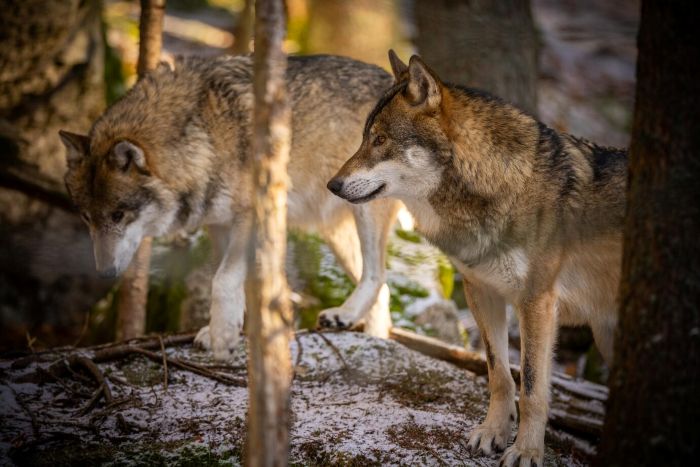When Colossal Biosciences announced the successful resurrection of the dire wolf after 12,500 years of extinction, much of the public attention focused on the stunning achievement of bringing back an Ice Age predator. However, behind the headlines lies an equally significant story: how the genetic technologies developed for this project are already helping to save critically endangered species today.
Founded by tech entrepreneur Ben Lamm and Harvard geneticist George Church, Colossal has positioned its de-extinction work not just as a scientific curiosity but as a pathway to developing new conservation tools. The dire wolf project has already demonstrated the potential of this approach.
Alongside the announcement of three dire wolf pups—Romulus, Remus, and Khaleesi—Colossal revealed it had successfully cloned four red wolves using the same genetic techniques. With fewer than 20 individuals remaining in the wild, the red wolf is North America’s most critically endangered canid, making this achievement potentially crucial for the species’ survival.
“It’s the lost genetics of the world’s most endangered wolf,” says Matt James, Colossal’s chief animal officer. “And we now have the opportunity to use our cloning and genetic-engineering tools to be able to confer that genetic diversity back into the recovery of the species.”
One major innovation enabling both projects is Colossal’s development of a less invasive cell-harvesting technique. Rather than taking tissue samples from donor animals—a procedure that can be stressful and potentially harmful—scientists isolated endothelial progenitor cells from blood draws, which can be collected during routine veterinary care.
“The idea that we could just take a vial of blood, isolate EPCs, culture them, and clone from them… we think it’s a game changer,” noted George Church, Colossal co-founder and Harvard genetics professor.
This approach allows genetic material to be preserved from endangered animals with minimal impact on their welfare—a crucial consideration when working with species whose numbers are already critically low. The technique could potentially be applied to many threatened species, creating biobanks of genetic material that could help maintain or even enhance genetic diversity.
For the red wolf project, this technique allowed researchers to create clones derived from individuals with genetic lineages distinct from those currently represented in the captive breeding population. By incorporating these clones into conservation efforts, Colossal could potentially increase the number of founding lineages by 25%, significantly enhancing the species’ genetic diversity and long-term viability.
The company has also discovered that wild canids along the Gulf Coast of Texas and Louisiana carry what are known as “ghost alleles”—genetic variations from red wolves that have persisted in hybrid populations despite the near-extinction of the species itself. By identifying and potentially incorporating these lost genetic elements, Colossal’s technology could further strengthen red wolf conservation.
Similar applications are being explored for other endangered species. Colossal is working on genetic modifications that could help the northern quoll, a small marsupial native to Australia that’s threatened by the toxic cane toad. By identifying a single nucleotide change that could confer 5,000-fold resistance to cane toad toxin, researchers hope to create “super quolls” that can safely prey on the invasive amphibians.
Beyond these specific interventions, the genetic technologies developed for the dire wolf project could potentially address one of the most pressing challenges in conservation biology: genetic bottlenecks. When a species’ population drops to critically low levels, the resulting loss of genetic diversity can lead to inbreeding, reduced fitness, and vulnerability to disease—a predicament faced by countless endangered species today.
By preserving genetic material through their blood-based cloning technique and potentially enhancing genetic diversity through targeted modifications, Colossal’s approach could provide new tools for addressing these challenges.
“We are an evolutionary force at this point,” says Beth Shapiro, Colossal’s chief science officer, speaking of humanity’s role in shaping biodiversity. “We are deciding what the future of these species will be.”
The Center for Biological Diversity suggests that 30% of the planet’s genetic diversity could be lost by 2050, and Lamm insists that genetic engineering represents a vital tool to reverse this trend. Rather than viewing de-extinction as a scientific curiosity, he frames it as a moral imperative—a way for humans, who have driven so many species to the brink, to help restore balance to natural ecosystems.
This perspective has resonated with diverse stakeholders. The MHA Nation tribes (Mandan, Hidatsa, and Arikara) have collaborated with Colossal on the dire wolf project and expressed interest in having the animals live on their lands, seeing potential cultural and ecological benefits. Similarly, the State of North Dakota has invested in Colossal with an eye toward helping preserve their dwindling bison population.
“The de-extinction of the dire wolf is more than a biological revival. Its birth symbolizes a reawakening – a return of an ancient spirit to the world,” shared MHA Nation Tribal Chairman Mark Fox. “The work of the team at Colossal Biosciences is not only significant to our lands and people, but for conservation efforts across the globe.”
Through their pioneering work with dire wolves and other species, Ben Lamm and his team at Colossal Biosciences are demonstrating that de-extinction technology isn’t just about bringing back lost species—it’s about creating new tools and approaches that could help prevent future extinctions. By merging cutting-edge genetic science with conservation biology, they’re offering new hope for biodiversity in an era of unprecedented environmental challenges.





